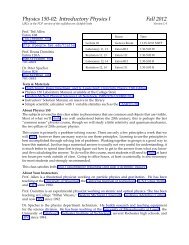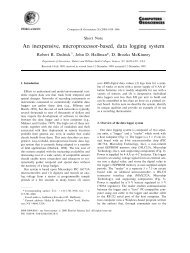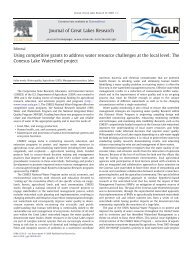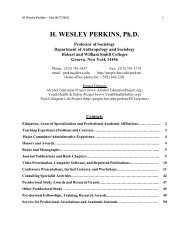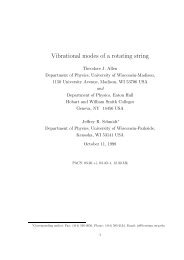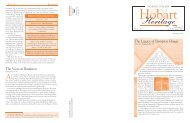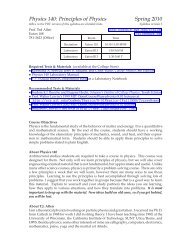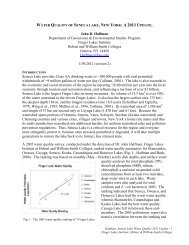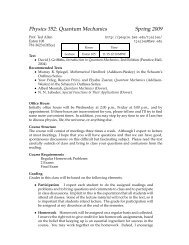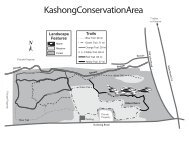Geology of New Zealand Field Trip Guidebook - ResearchGate
Geology of New Zealand Field Trip Guidebook - ResearchGate
Geology of New Zealand Field Trip Guidebook - ResearchGate
Create successful ePaper yourself
Turn your PDF publications into a flip-book with our unique Google optimized e-Paper software.
preserved as coal and the floodplain sediments entombed dinosaurs and a variety <strong>of</strong> marine<br />
reptiles (McSaveney and Nathan 2007).<br />
At the same time, a rift began to develop along the eastern margin <strong>of</strong> Gondwana, well<br />
inland <strong>of</strong> the newly-formed coastal mountains. Rift-associated volcanoes spewed mafic<br />
rocks onto the surface. These are today visible in Mount Peel, the Malvern Hills and Mount<br />
Somers in Canterbury. By about 85 Ma, the ocean had flooded the rift (Fig. 3) and <strong>New</strong><br />
<strong>Zealand</strong> was isolated from Australia. Seafloor spreading continued for about 30 Ma and<br />
mysteriously stopped, leaving the modern Tasman Sea (McSaveney and Nathan 2007).<br />
A marine section at Woodside Creek in Marlborough preserves a thick clay layer with<br />
high levels <strong>of</strong> the element iridium, marking the moment in time when a large meteor struck<br />
Earth (Alvarez et al. 1980) and precipitating the extinction <strong>of</strong> the non-avian dinosaurs and<br />
heaps <strong>of</strong> other animals and plants on land and in the sea. The ecological havoc wrecked by<br />
this event is also witnessed in <strong>New</strong> <strong>Zealand</strong> in the form <strong>of</strong> a superabundance <strong>of</strong> fern spores<br />
just above (after) the impact layer (Vajda et al. 2001, Hollis 2003). A similar layer is<br />
observed in North America and is widely interpreted to indicate a disturbance flora rich in<br />
ferns that colonized the landscape after the impact catastrophe (Tschudy et al. 1984, 1986).<br />
Although the Woodside Creek sediments were marine, their pollen content shows that<br />
land was nearby. Terrestrial rocks in Canterbury preserve the leaves <strong>of</strong> some <strong>of</strong> the plants<br />
responsible for this pollen. Since leaves are so essential to the functioning <strong>of</strong> plants, they are<br />
commonly highly adapted to the particular environments in which they are found. As a<br />
result, fossil leaves can be used to reconstruct climates <strong>of</strong> the past. Work by Elizabeth<br />
Kennedy showed that the diversity <strong>of</strong> angiosperms (flowering plants) declined significantly<br />
following the Cretaceous-Tertiary extinction, but climate didn’t change too much (Kennedy<br />
2003). <strong>New</strong> <strong>Zealand</strong> remained cool to mild (mean annual temperature 6-12°C, today’s MAT<br />
ranges from 10-16°C depending on location) and temperate with abundant rainfall throughout<br />
this period <strong>of</strong> change.<br />
While a significant portion <strong>of</strong> the <strong>Zealand</strong>ia was above sea level during the early<br />
phases <strong>of</strong> rifting from Gondwana, as rifting slowed and eventually ceased, the continent<br />
cooled and sank into the mantle below, submerging large regions. The Late Cretaceous and<br />
Paleocene terrestrial rocks <strong>of</strong> Canterbury show clearly that this part <strong>of</strong> present-day <strong>New</strong><br />
<strong>Zealand</strong> was still above sea level, but a detailed look at the sediments shows that by<br />
Oligocene time, less than one third <strong>of</strong> present-day <strong>New</strong> <strong>Zealand</strong> was above the waves. What<br />
land remained was isolated into a serious <strong>of</strong> relatively small islands (McSaveney and Nathan<br />
2007). Many <strong>of</strong> these islands were capped with low-lying coastal swamps, from which most<br />
<strong>of</strong> <strong>New</strong> <strong>Zealand</strong>’s coal comes. Between the islands, carbonates (limestone) accumulated in<br />
shallow seas (McSaveney and Nathan 2007).<br />
This sinking may partially explain the paucity <strong>of</strong> animal diversity on <strong>New</strong> <strong>Zealand</strong>.<br />
The only native mammals, for example, are bats, that could disperse to the island relatively<br />
recently. Instead, <strong>New</strong> <strong>Zealand</strong>’s terrestrial fauna is rich in birds, both flying and flightless.<br />
Some members <strong>of</strong> the ratite (emu) family, such as the moas, were likely flightless when<br />
<strong>Zealand</strong>ia rifted from Gondwana. Others likely lost flight after immigration. Nonetheless,<br />
the extreme fragmentation <strong>of</strong> <strong>New</strong> <strong>Zealand</strong>’s land mass may explain some <strong>of</strong> its diversity<br />
patterns. A good terrestrial fossil record is needed to flesh out this story. However, such a<br />
record—if it exists—has yet to come to light.<br />
By the end <strong>of</strong> the Oligocene, the modern configuration <strong>of</strong> plate boundaries had been<br />
established (Fig. 3). To the north, the Pacific Plate was sinking beneath continental rocks <strong>of</strong><br />
the Australian Plate. The Pacific Plate was rotating relative to the Australian plate producing<br />
shear stress that initiated the formation <strong>of</strong> the Alpine Fault. Despite the dominant shear<br />
motion, significant compression still occurred, lifting much more land above sea level and<br />
exposing more <strong>of</strong> modern <strong>New</strong> <strong>Zealand</strong>. Uplift continues today and appears to be<br />
14




